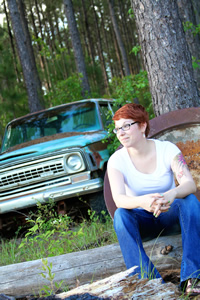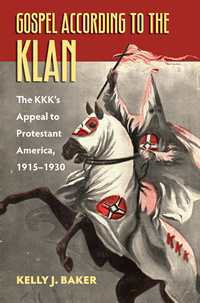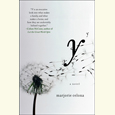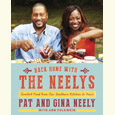Night-Riders Redux
Knoxville historian Kelly J. Baker examines the religious underpinnings of the Klan’s reemergence in the twentieth century
By the time I was old enough to know what the Klan was, it had already become a punchline. About once a year the Nashville news would carry footage of a desultory march around War Memorial Plaza, a clutch of pasty, paunchy men in white robes and dunce caps, not even bothering to cover their faces. The Klan was still preaching hate, but its voice had collapsed to a whisper.
Needless to say, the Klan was everything that self-respecting, middle-class Nashvillians like my family were not: uneducated, rural, redneck. And yet they were also people from whom, by ancestry, we might not be all that distant—a thought at once humbling and empowering. There but for the grace of God go we.
There was a time, though, when the Klan was anything but a fringe object of nervous middle-class disdain. In the 1920s, the order claimed nearly four million dues-paying members, or about fifteen percent of the total eligible population, with chapters in all forty-eight states. Its ranks drew from the burgeoning white-collar professions: doctors, lawyers, accountants, middle managers. Like the Rotary Club’s evil twin, the Klan attracted political climbers looking to build social capital: future senators Robert Byrd of West Virginia and Hugo Black of Alabama (who went on to the Supreme Court) were once card-carrying members.
 Far from the terrifying night riders depicted in the film Birth of a Nation, the 1920s Klan was thoroughly bourgeois: it sponsored picnics, ran youth and women’s auxiliaries, and published dozens of weekly and monthly newspapers. Its members were politicians and editors; one ran the newspaper in Pekin, Illinois, and let the local chapter write a weekly column.
Far from the terrifying night riders depicted in the film Birth of a Nation, the 1920s Klan was thoroughly bourgeois: it sponsored picnics, ran youth and women’s auxiliaries, and published dozens of weekly and monthly newspapers. Its members were politicians and editors; one ran the newspaper in Pekin, Illinois, and let the local chapter write a weekly column.
The twentieth-century Klan appeared in 1915; its previous iteration (founded in Pulaski, Tennessee, after the Civil War) had quickly been suppressed. How did it reemerge so rapidly? How, asks Kelly J. Baker, a lecturer in religious and American studies at the University of Tennessee in Knoxville and author of Gospel According to the Klan, did an organization we find so reprehensible today occupy a place so close to the center of the American mainstream?
One reason is that, put simply, the Klan was mainstream because racism was mainstream. Whether they lived in the Jim Crow South or elsewhere, the overwhelming majority of early-twentieth-century whites assumed without question that blacks (and Italians, and Jews, and Chinese, and anyone else) were inferior to the carriers of Anglo-Saxon DNA. Casual racism infected everyday life; in a 1924 letter written on a trip through Tennessee and Mississippi, future Illinois senator Everett Dirksen noted the poor region’s “residue of white trash and n—–s.” And Dirksen, who never joined the Klan and would later co-sponsor the 1964 Civil Rights Act, was one of the good ones.
 The second reason, and the one that lies at the heart of Baker’s book, is religion. The Klan was never just about white supremacy: it was about Protestant white supremacy. In the face of millions of immigrating Europeans—most of them Catholic, and many of the remainder Jewish—the Klan promoted a worldview centered on what Baker calls “a new path of militant Protestantism and sacred patriotism.” These “values” were hardly unique to the order, but it fomented an appealing militancy to defend them, casting male members in the role of virile knights protecting home and country. “The Klan,” Baker writes, “was not a movement of the right-wing fringe but a movement of white Protestant citizens who wanted to protect their dominance and their culture.”
The second reason, and the one that lies at the heart of Baker’s book, is religion. The Klan was never just about white supremacy: it was about Protestant white supremacy. In the face of millions of immigrating Europeans—most of them Catholic, and many of the remainder Jewish—the Klan promoted a worldview centered on what Baker calls “a new path of militant Protestantism and sacred patriotism.” These “values” were hardly unique to the order, but it fomented an appealing militancy to defend them, casting male members in the role of virile knights protecting home and country. “The Klan,” Baker writes, “was not a movement of the right-wing fringe but a movement of white Protestant citizens who wanted to protect their dominance and their culture.”
Though members remained adherents to their particular denominations, one could argue that the Klan created its own church, with a robust theology that bordered on myth. America was not simply a blessed country: its white Protestants were the end result of thousands of years of divinely directed racial development. The Klan also borrowed heavily from the “muscular Christianity” movement that swept the country in the 1920s, claiming to be the cultural descendants of tough-minded American leaders like Jonathan Edwards and Abraham Lincoln. In this way, the Klan could say that it was not against foreigners, blacks, and Catholics but for native-born white Protestants, a message that helped soften its image, particularly among urban converts.
The fall of the Klan was as quick as its rise. Internal power struggles, negative press, and opposition from progressive and urban politicians pushed members away in droves. What was left was a hard nub of racist nativism, an ideological core that during the rest of the century drifted further and further toward the violent fringe.
In Gospel According to the Klan, Baker makes a strong case that the history of the Klan demonstrates the way “intolerance is as American as ideals of tolerance and freedom.” The Klan, far from occupying a radical corner of American social and religious history, once played an underappreciated role in shaping it.
Clay Risen is a regular Chapter 16 contributor and the author of A Nation on Fire: America in the Wake of the King Assassination.


